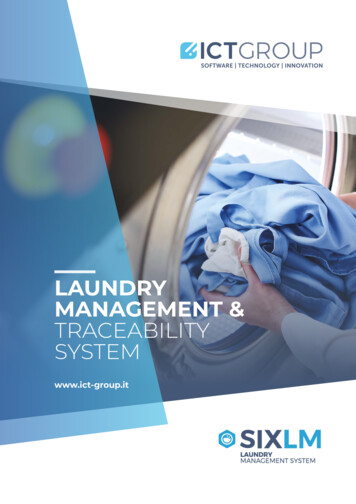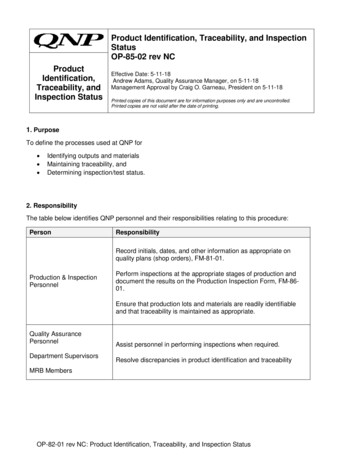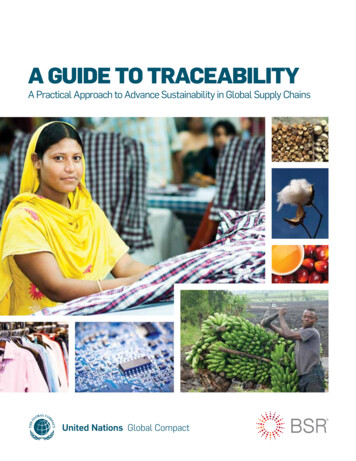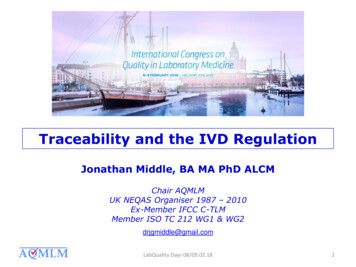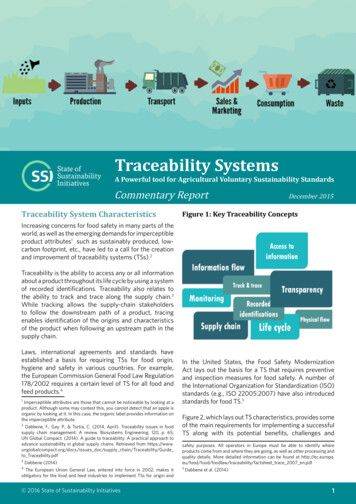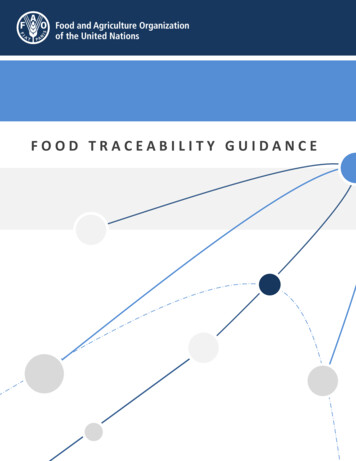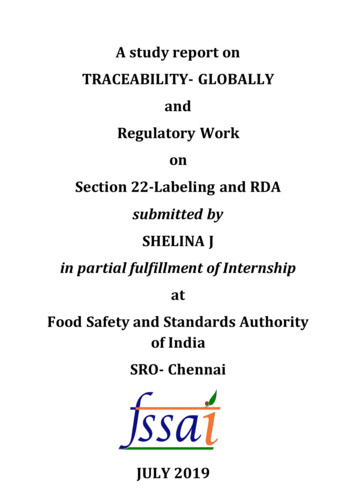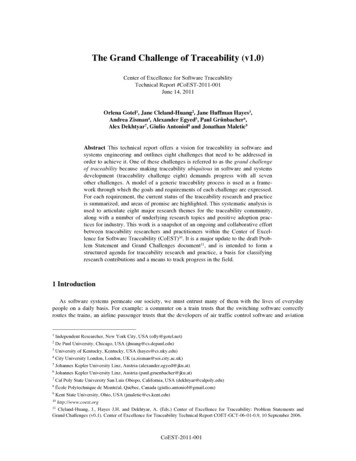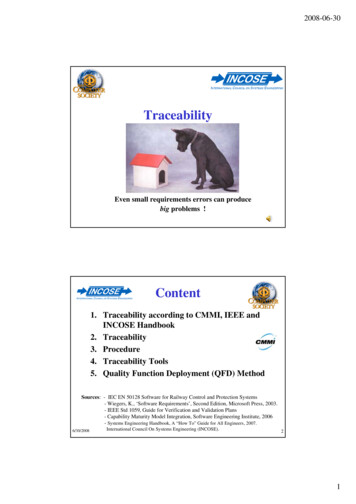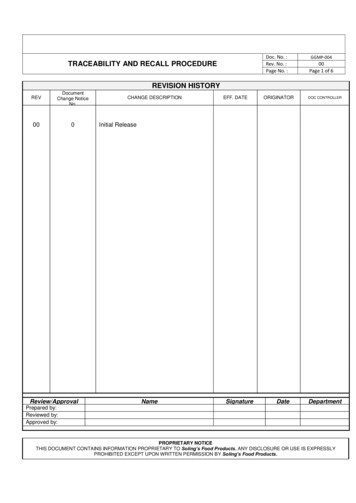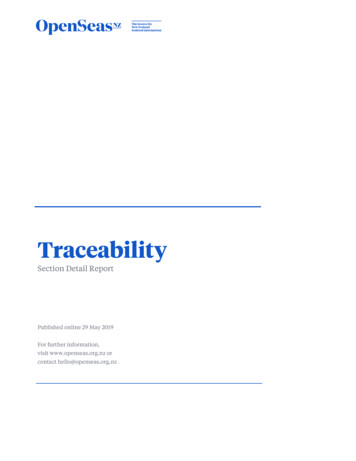
Transcription
TraceabilitySection Detail ReportPublished online 29 May 2019For further information,visit www.openseas.org.nz orcontact hello@openseas.org.nz .
OverviewTraceability of seafood in New Zealand extends from “sea to plate”. While the primary purpose of traceability systems is toensure that an effective recall can be undertaken quickly and effectively, they also provide the seafood business operatorwith a level of transparency and integrity.This report details the approach, implementation and conformance measures that specifically relate to traceability ofseafood produced in New Zealand.Traceability of food in New Zealand is regulated under food safety legislation. The details of New Zealand’s food safetysystem (including Animal Products Act 1999 and the Food Act 2014) are discussed in the Food Safety Section Detail Report.This report should therefore not be read in isolation from the Food Safety Section Detail Report.The New Zealand approachThe objective of New Zealand’s traceability system is to allow for the identification and tracking of product as it moves alongthe supply chain. For seafood this is from the point of harvest or catch through to retail sale (if consumed in New Zealand)or to the point of export. Seafood operators are required to have systems that allow product to be identified and tracked on a‘one up, one back’ basis.While the systems and processes that individual businesses use may differ, the legislation requires them to keep records ofkey events that occur while the seafood is in their control, including who it was received from, what was received, theprocessing that occurred and to whom it was sold. This means that full traceability exists along the supply chain.Figure 1. Simplified traceability modelAnimal Products ActThe Animal Products Act was amended in 2018 to specify: A regulated person must, as and when required by regulations : have in place any procedures for tracing and recalling animal material or animal products; andconduct simulations or other tests of those procedures; andimplement those procedures to trace or recall animal material or animal products.Section Detail Report Traceability, published 29 May 20191
Animal Products LegislationThe Regulations specify the following traceability requirements: All operators of risk management programmes, all exporters, and all other categories of person required byspecifications to do so, to have a tracking system that allows for the identification of animal material and animalproduct and enables the movement of that animal material or animal product to be traced (from origin or supplier,while it is under the businesses control and to the next recipient) Animal material and animal product must be labelled or identified or contain information that accurately describesor differentiates so as to identify the animal material or animal product to which it applies.The Animal Products Act also has several supporting notices which include requirements for inventory control and recall.For example, operators are required to document and implement procedures to manage inventory control, as required bythe Animal Products Notice: Specifications for Products intended for Human Consumption and Animal Products Notice:Specifications for Products intended for Animal Consumption.The Animal Products (Risk Management Programme Specifications) Notice 2008 contains the following with respect torecall: Where, due to the nature of the animal material or animal product it is possible to recall it from trade, distributionor consumers, a risk management programme must contain a recall procedure, including — othe criteria for deciding when a recall will be initiated; andohow retrieval and disposition of the relevant animal material or animal product will be managed.A risk management programme must contain a system for notifying the following people as soon as possible whenanimal material or animal product is recalled from trade, distribution or from consumers because it is not or maynot be fit for its intended purpose;othe Director-General; andothe recognised risk management programme verifier or recognised.The Food RegulationsThe Regulations specify the following traceability and identification requirements: The operator must have procedures for identifying and tracing food so that it can be traced from the supplier to thefood business, while it is under the control of the food business and from the food business to the next recipient inthe supply chain (other than the final consumer). The operator must ensure that food is identified and traced in accordance with the procedures.The Food Standards CodeThe Food Standards Code includes requirements and standards for food safety, labelling, food additives and other foods thatneed pre-approval (such as any genetically modified food), but also contains requirements that apply to Australianmanufactures only. It is divided into four parts, and with respect to traceability, Chapter One is that which is relevantincorporating labelling and identification requirements. Specifically, Standard 1.2.2 Information Requirements – FoodIdentification Requirements.Section Detail Report Traceability, published 29 May 20192
Complying with the New Zealand approachThe majority of seafood produced in New Zealand is produced in land-based premises or factory vessels operating under aRisk Management Programme, under the Animal Products Act.A Risk Management Programme is a documented system that ensures all products leaving the Risk ManagementProgramme, are fit for their intended purpose, and if intended for human consumption, also meet the requirements of theFood Standards Code. As part of this documented system, operators must document their procedures for ensuring theirtraceability obligations are met.For those seafood businesses operating under the Food Act, they must also document and implement procedures for theidentification and tracking of product as part of their compliance requirements.The New Zealand Seafood Standards Council and the Ministry for Primary Industries have jointly developed a Code ofPractice for the Processing of Seafood Products (The Code of Practice: Processing of Seafood Product). The objective of thecode is to outline the acceptable or agreed procedures for meeting the regulatory requirements. This includes guidance toassist seafood business operators to implement effective traceability systems.Further details are discussed in the Food Safety Section Detail Report.Conformance and enforcement measuresTraceability is required to be monitored and verified by both internal and external processes. A key component is therequirement for operators to conduct their own internal verification to ensure the system is effective.All operators are required to confirm that their system complies with the legislation. In terms of traceability, operators mustimplement a system that is designed to gather sufficient evidence to determine that their processes meet the requirements.This includes conducting activities to test the accuracy and effectiveness of their system, such as product trace-backexercises.External verification includes activities designed to determine whether an operator’s system, including traceability, are incompliance with the requirements of the programme and the Animal Products Act or Food Act (whichever applies). As partof this verification, operators are expected to be able to demonstrate the effectiveness of their traceability system to theirverifier.Frequency of verification for traceability is determined by the Performance Based Verification system. This system allowsthe frequency of external verification to be based on performance. With good performance, businesses face less frequentexternal verification. Poor performance results in more frequent external verification. For the seafood businesses thatexport, the frequency is capped at 6-monthly audits, with a 12-weekly load-in and load-out audit. For those businesses whosolely sell on the New Zealand market, the frequency is capped at annual audits.The Ministry holds data on the frequency and number of verifications undertaken. However, this information is not publiclyreported.In term of exports, the Ministry cannot issue official assurances unless the business has demonstrated compliance throughexternal verification. This requirement on the Ministry is prescribed in legislation.Section Detail Report Traceability, published 29 May 20193
Non-complianceNon-compliance can result in a series of enforcement actions depending on the severity of the breakdown in traceability. Asa minimum, operators are required to identify and correct any non-compliance, as outlined in the Food Safety Section DetailReport.The Animal Products Act prescribes penalties for offences against the Act1. Offences can result in fines and/or imprisonmentfor persons or body corporates.Comparability to international best practiceSome New Zealand seafood companies have obtained Marine Stewardship Council (MSC) Chain of Custody certification,which verifies the integrity of traceability systems for MSC certified products2.There is currently no global, secure, interoperable support system for seafood traceability.3 Both New Zealand seafoodcompanies and the New Zealand government maintain an active watching brief on global developments to enhancetraceability of seafood.ReferencesAnimal Products Act 1999. Available from: 3/latest/DLM33502.htmlAnimal Products Regulations 2000. Available lic/2000/0207/latest/DLM9546.htmlAnimal Products (Risk Management Programme Specifications) Notice 2008. Available licystatement/Animal Products-Contains That.pdfAnimal Products Notice: Specifications for Products Intended for Human Consumption. Available mal Products Notice: Specifications for Products Intended for Animal Consumption. Available gedInFood Regulation 2016. Available lic/2015/0310/latest/DLM6684402.html?search sw 096be8ed81808b83 identifying 25 se&p 1&sr 13Animal Products Notice: Export Verification Requirements. Available /requirements/Bhatt, T., et al. 2016. Project to Develop an Interoperable Seafood Traceability Technology Architecture: Issues Brief.Comprehensive Reviews in Food Science and Food Safety. Vol.15,2016.Part 10 of the Animal Products Act ler.aspx?Path be2ac378-2a36-484c-8016-383699e2e466&xf 1&Country New%20Zealand3Bhatt, T. (2016)12Section Detail Report Traceability, published 29 May 20194
Code of Practice: Processing of Seafood Products. Available from: depractice-seafood/Food Act 2014. Available 4/0032/latest/DLM2995811.html?search ta act F ac%40ainf%40anif an%40bn%40rn 25 a&p 4Food Regulations 2015. Available lic/2015/0310/latest/whole.html#DLM6684211Food Standards Code. Available from: .aspxSeafood legislation road map (links to all seafood related legislation). Available food-roadmap/loggedinSection Detail Report Traceability, published 29 May 20195
Report DetailsSectionTraceabilityReport author(s)Cathy Webb, Seafood Standards Manager, Seafood Standards Council4Date of draft report5 February 2019Legislative reviewLisa Olsen, Principal Adviser (Animal Products), Ministry for Primaryprovided byIndustriesDate of review1 April 2019Date of final report1 April 2019Relevant legislation,Animal Products Act 1999regulation and statuesAnimal Products Regulations 2000Animal Products Notice: Specifications for Products intended for HumanConsumptionAnimal Products Notice: Specifications for Products intended for AnimalConsumptionAnimal Products (Risk Management Programme Specifications) Notice 2008Animal Products Notice: Export Verification RequirementsFood Act 2014Food Regulations 2015Food Standards CodeRelevant regulatoryMinistry for Primary Industries www.mpi.govt.nzagenciesFood Standards Australia New Zealand www.foodstandards.govt.nzThe Seafood Standards Council is an official committee of Seafood New Zealand Limited in cooperation with the Ministry for PrimaryIndustries. It is primarily concerned with the assurance of food safety and market access for seafood produced in New Zealand. Moreinformation can be found at www.nzssc.co.nz.4Section Detail Report Traceability, published 29 May 20196
have in place any procedures for tracing and recalling animal material or animal products; and conduct simulations or other tests of those procedures; and implement those procedures to trace or recall animal material or animal products. Section Detail Report Traceability, published 29 May 2019 2 Animal Products Legislation The Regulations specify the following traceability requirements: All .
